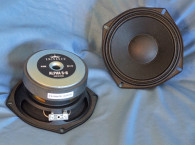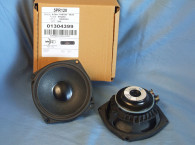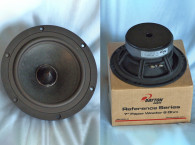



The feature set for the Eton 4-512 includes a proprietary four-spoke cast aluminum frame that minimizes reflections back into the cone. The frame also incorporates 12 of the 6 mm × 6 mm vents below the spider mounting shelf for cooling. Additional cooling comes from the 10 mm diameter pole vent.
The cone assembly consists of a specially formed serrated paper cone, with a 25 mm diameter shaped (and serrated) black aluminum phase plug, suspended with a NBR surround, an elevated cloth spider (damper) connected at the neck joint to a 25 mm diameter voice coil wound with round copper wire on a Kapton non-conducting former. Powering the cone assembly is a 17 mm × 90 mm ferrite magnet with a milled and polished front plate and T-yoke. Tinsel leads connect on one side of the cone to a pair of solderable terminals.
I began testing the Eton 4-512, using the LinearX LMS analyzer and VIBox to create both voltage and admittance (current) curves. During testing, I clamped the driver to a rigid test fixture in free air at 0.3 V, 1 V, 3 V, 6 V, and 10 V with the 10 V curves remaining linear enough for LEAP 5 to get a good curve fit—impressive for a 4” driver. As has become the protocol for Test Bench testing, I no longer use a single added mass measurement and instead use actual measured mass—the manufacturer’s measured Mmd data (4.27 grams).



Next, I post-processed the 10 550-point stepped sine wave sweeps for each of the Eton 4-512 samples and divided the voltage curves by the current curves (admittance) to produce the impedance curves, phase generated by the LMS calculation method. I imported them, along with the accompanying voltage curves, to the LEAP 5 Enclosure Shop software. Since most Thiele-Small (T-S) data provided by OEM manufacturers is produced using either a standard driver model or the more advanced LEAP 4 TSL model, I additionally created a LEAP 4 TSL model using the 1 V free-air curves. I selected the complete data set, the multiple voltage impedance curves for the LTD model, and the 1 V impedance curve for the TSL model in LEAP 5’s transducer derivation menu and created the parameters for the computer box simulations. Figure 1 shows the 1 V free-air impedance curve. Table 1 compares the LEAP 5 LTD and TSL data and factory parameters for both of the Eton 4-512 samples.
LEAP TSL/LTD parameter calculation results for the Eton 4-512 was reasonably close to the factory data. As is often the case, on the surface the T-S data can look like it’s not so close when compared to drivers from a different production batch, however, the various ratios such as Fs/Qt can be nearly identical. To be certain, I programmed the factory data into LEAP 5 Enclosure Shop and the curves for the vented example closely overlaid the curve obtained by LMS. However, following my usual protocol, I configured computer enclosure simulations using the LEAP LTD parameters for Sample 1. This consisted of a 50 in3 Butterworth sealed box with 50% damping material (fiberglass), and a 79 in3 Quasi third-order Butterworth (QB3) vented enclosure tuned to 92 Hz with 15% damping material in the box.
Figure 2 shows the results for the Eton 4-512 in the sealed and vented box simulations at 2.83 V and at a voltage level sufficiently high enough to increase cone excursion to Xmax + 15% (2.3 mm for the 4-512). This produced a F3 frequency of 178 Hz (F6 = 139 Hz) with a Qtc = 0.67 for the 50 in3 Butterworth sealed enclosure and –3 dB = 135 Hz (F6 = 110 Hz) for the 79 in3 QB3 vented simulation. Increasing the voltage input to the simulations until the maximum linear cone excursion was reached resulted in respectable 104 dB at 16.5 V for the sealed Butterworth enclosure simulation and 106 dB with the same 16.5 V input level for the Quasi third-order Butterworth vented enclosure. Figure 3 shows the 2.83 V group delay curves. Figure 4 shows the 16.5 V excursion curves.





Klippel analysis for the Eton 5-412 produced the Bl(X), Kms(X) and Bl and Kms symmetry range plots given in Figures 5–8. (Our analyzer is provided courtesy of Klippel GmbH and the testing is performed by Pat Turnmire, of Redrock Acoustics.) The Bl(X) curve for the 4-512 (see Figure 5) is typically narrow for a low Xmax driver, but relatively symmetrical with minor amount of offset to the curve, but not bad for a short Xmax 4” diameter driver. Looking at the Bl symmetry plot (see Figure 6), this curve shows a minor coil-in (rearward) offset at the driver’s physical 2 mm Xmax (a reasonable area of certainty) of a trivial 0.34 mm.
Figure 7 and Figure 8 show the Kms(X) and Kms symmetry range curves. The Kms(X) curve shown in Figure 7 is less symmetrical, with some tilt. The curve also indicates some forward (coil-out) offset at the Xmax position. Looking at the Kms symmetry range curve shown in Figure 8, there is about 1.15 mm offset at the physical Xmax position. While this is a lot for a short 2 mm Xmax driver, the Eton 4-512 will likely be used in an application with an appropriate high-pass filter inserted.
Displacement limiting numbers calculated by the Klippel analyzer were XBl @ 82% Bl is 3 mm and the crossover (XC) at 75% Cms minimum was 1.9 mm, which means compliance is the most limiting factor for prescribed distortion level of 10%, but it also occurs right at the physical Xmax, so not bad. Figure 9 gives the inductance curve Le(X). Inductance will typically increase in the rear direction from the zero rest position as the voice coil covers more pole area, which is what happens here. However, the inductance variation from Xmax in to Xmax out is only 0.011 mH, which is more than acceptable.





Next I mounted the Eton 4-512 in an enclosure, which had an 11” × 5” baffle and was filled with damping material (foam). Then, I measured the transducer on and off axis from 300-Hz-to-40-kHz frequency response at 2.83 V/1 m, using the Linear LMS analyzer set to a 100-point gated sine wave sweep. Figure 10 gives the on-axis response of the Eton 4-512 that is ±2.4 dB in the typical operation range of 500 Hz to 5 kHz with no significant response anomalies. Figure 11 displays the on- and off-axis frequency response at 0°, 15°, 30°, and 45°. The -3 dB from the on-axis curve to the 30° off-axis response occurs at about 4.6 kHz, so a crossover between 3 kHz and 4.5 kHz would be reasonable for this driver.
Figure 12 gives the off-axis curves normalized to the on-axis response, with the CLIO 180° polar plot (measured in 10° increments) depicted in Figure 13. The two-sample SPL comparison is illustrated in Figure 14, indicating the two samples were closely matched within less than 1 dB in the normal operating range of the transducer.



Next, I employed the Listen, Inc. SoundCheck V15 software, along with the AmpConnect analyzer with the Listen 0.25” SCM microphone and power supply (courtesy of Listen, Inc.) to measure distortion and generate time-frequency plots. For the distortion measurement, I mounted the Eton 4-512/C8/25 RP rigidly in free air. I used a noise stimulus to set the SPL to 94 dB at 1 m (6.79 V) and measured the distortion with the microphone placed 10 cm from the dust cap. This produced the distortion curves shown in Figure 15. I used SoundCheck to get a 2.83 V/1 m impulse response and imported the data into Listen’s SoundMap Time/Frequency software. Figure 16 shows the resulting CSD waterfall plot. Figure 17 shows the Wigner-Ville plot (for its better low-frequency performance).
Overall, the Eton 4-512 is a nicely executed midrange driver with the excellent build quality you expect from a high-end OEM like Eton. For more information, visit www.eton-gmbh.com. VC
This article was originally published in Voice Coil, December 2017.







